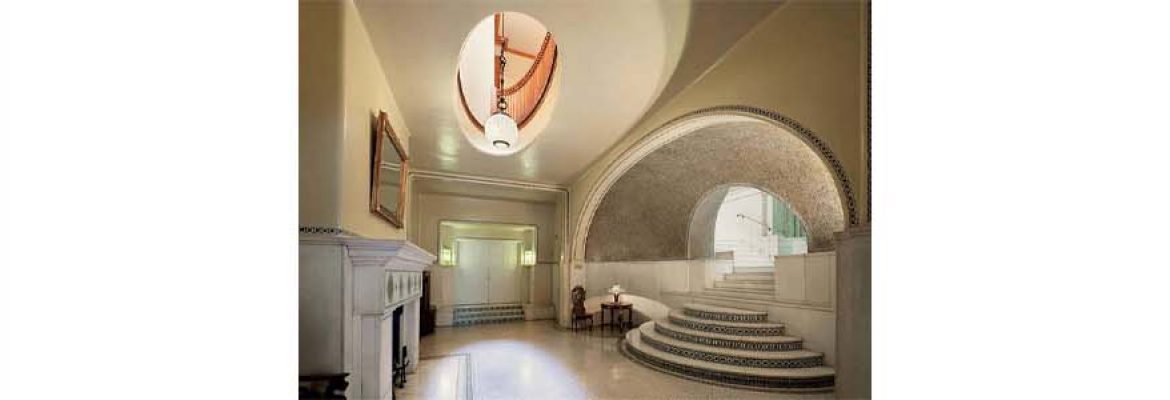Ayer Mansion
Boston’s Tiffany Treasure. Built between 1899 and 1902 for businessman and art collector Frederick Ayer, the Ayer Mansion is the country’s only surviving residence created by famed American artist and designer, Louis Comfort Tiffany. Named a National Historic Landmark in 2005, the Ayer Mansion exemplifies what critics of the day called Tiffany’s “dumbfounding versatility.” At the Ayer Mansion, Tiffany-designed stone and glass mosaics, graceful metalwork, Favrile glass vases, custom furniture, intricate plaster work, elaborate art glass windows, and unexpected architectural flourishes all work together to create a cohesive masterpiece. Since 1998, the Campaign for the Ayer Mansion has been restoring and preserving this singular treasure. Now home to the non-profit Bayridge Residence & Cultural Center, the Ayer Mansion is open monthly for scheduled public tours and by appointment as well as during its annual lecture series and other public events.
Tours of the Ayer Mansion are usually offered at least one Saturday and one Wednesday a month (with the exception of August, when the house is closed to the public) and are posted two months in advance. Tours last approximately one and a quarter hour. Reservations are required for all public tours as space is limited. If you have reserved a spot, but cannot attend, please let us know so that we can plan accordingly.
Come experience Louis Comfort Tiffany’s vision for a grand Boston home. A Rare Surviving Tiffany Gem. The Ayer Mansion at 395 Commonwealth Avenue in Boston, Massachusetts is a rare surviving example of the residential work of artist Louis Comfort Tiffany. A master of surface ornament and color, Tiffany helped pioneer the interior design profession and revolutionize the art of stained glass. He was the “most fashionable purveyor of taste” during America’s Gilded Age at the turn of the twentieth century. His influence extended beyond the American home, to every type of public and private institution. It also reached beyond the United States to Europe where he was praised for his “dumbfounding versatility.”
The Ayer Mansion is one of only three surviving Tiffany intact residential commissions, which include the interiors of the Samuel L. Clemens (Mark Twain) House in Hartford, Connecticut (1881) and the Pierre Ferry House in Seattle, Washington (1903–1906), both of which are actually redesigns by Tiffany. The Ayer Mansion stands alone as the sole example of a house designed from its inception by the artist.
The Ayer Mansion also displays the only known example of surviving Tiffany exterior decoration in situ. While Tiffany is known to have designed dozens of interiors during his 50-year career, he rarely undertook exterior ornamentation. His own house, Laurelton Hall in Oyster Bay, Long Island and the Ayer Mansion are the only two known exceptions. Of these two, only the Ayer Mansion survives intact; Laurelton Hall burned to the ground in the 1950s and individual components of its exterior can be seen at the Metropolitan Museum of Art in New York City and the Charles Hosmer Morse Museum of American Art in Winter Park, Florida.
The Ayer Mansion exemplifies several of Tiffany’s innovative contributions to American design. The façade and entrance hall comprise a coherent, integrated composition. This continuity of design resulted in a total, unified work of art, a concept that “Tiffany heralded in America.” Within the composition, Tiffany included art glass and mosaic surfaces using convention-breaking techniques and materials pioneered decades earlier by Tiffany himself. For example, the interior includes opalescent glass, semi-transparent glass backed by metallic foil, and “plated” surfaces.
In addition to founding the interior design profession, Tiffany also established and popularized new tastes for interior spaces. In the 1870s, influenced by his own extended travel, he and his fellow Associated Artists helped create widespread interest in Orientalism: the art of Persia, India, Byzantium, Japan, and North Africa. The art of the East remained a dominant influence in his designs throughout his career. At the Ayer Mansion, austere architectural forms and smooth surfaces provide a foil for the rich Near Eastern patterns and color combinations and for his experimental glass.


